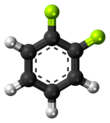1,2-Difluorobenzene
| |||
| Names | |||
|---|---|---|---|
| Preferred IUPAC name
1,2-Difluorobenzene | |||
| Other names
o-Difluorobenzene
ortho-Difluorobenzene | |||
| Identifiers | |||
3D model (JSmol)
|
|||
| ChEBI | |||
| ChemSpider | |||
| ECHA InfoCard | 100.006.074 | ||
PubChem CID
|
|||
| UNII | |||
CompTox Dashboard (EPA)
|
|||
| Properties | |||
| C6H4F2 | |||
| Molar mass | 114.093 g/mol | ||
| Appearance | colorless liquid | ||
| Density | 1.1599 g/cm3 | ||
| Melting point | −34 °C (−29 °F; 239 K) | ||
| Boiling point | 92 °C (198 °F; 365 K) | ||
| (insoluble) 1.14 g/L | |||
Except where otherwise noted, data are given for materials in their standard state (at 25 °C [77 °F], 100 kPa). | |||
| Infobox references | |||
1,2-Difluorobenzene, also known as DFB, is an aromatic compound with formula C6H4F2. This colorless liquid is a solvent used in the electrochemical studies of transition metal complexes.
Synthesis[]
1,2-Difluorobenzene is prepared by a simple substitution reaction of fluorine with fluorobenzene.[citation needed]
- C6H5F + F2 → C6H4F2 + HF
The 1,4-isomer and small amounts of the 1,3-isomer are also produced in the reaction as the fluorine group on the aromatic ring of fluorobenzene is ortho- and para- directing.
Applications[]
1,2-Difluorobenzene has been used as solvent for the electrochemical analysis of transition metal complexes. It is relatively chemically inert, weakly coordinating, and has a dielectric constant high enough to dissolve many electrolytes and metal complex salts. It is used as a weakly coordinating solvent for metal complexes, alternative to the relatively more strongly coordinating solvents acetonitrile, DMSO, and DMF.[2]
It has a role as an anaesthetic.[3]
1,2-Difluorobenzene can be acylated to 3',4'-difluoropropiophenone, which has interesting application in the synthesis of halogenated cathinone/PPA congeners.[4]
Hazards[]
DFB is a highly flammable liquid and vapour. Hazardous decomposition products formed under fire conditions include carbon oxides, and hydrogen fluoride. Handle with thick fluorinated rubber gloves.[5]
References[]
- ^ David R. Lide, ed., CRC Handbook of Chemistry and Physics, 89th Edition (Internet Version 2009), CRC Press/Taylor and Francis, Boca Raton, FL.
- ^ O'toole, Terrence R.; Younathan, Janet N.; Sullivan, B. Patrick; Meyer, Thomas J. (1989). "1,2-Difluorobenzene: a relatively inert and noncoordinating solvent for electrochemical studies on transition-metal complexes". Inorganic Chemistry. 28 (20): 3923. doi:10.1021/ic00319a032.
- ^ "1,2-Difluorobenzene". PubChem. Retrieved 11 February 2021.
- ^ GB 1140754
- ^ "SAFETY DATA SHEET". Sigma-Aldrich. September 28, 2019. Retrieved 11 February 2021.
- Fluoroarenes
- Halogenated solvents
- Aromatic solvents

